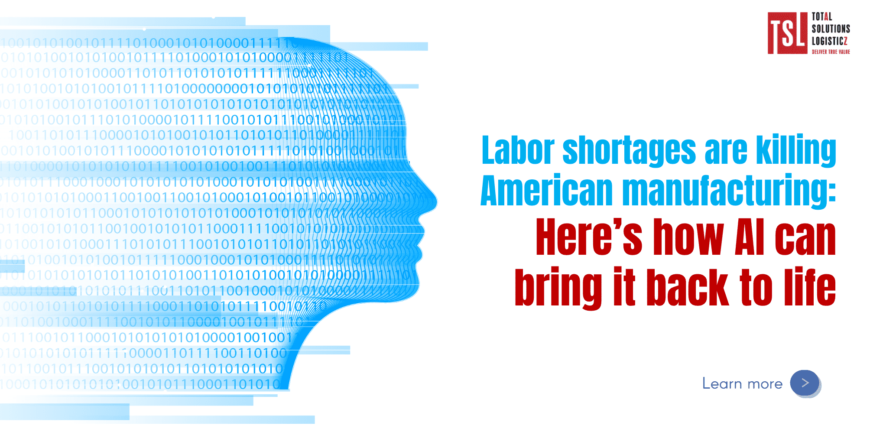Labor shortages are killing American manufacturing. Here’s how AI can bring it back to life.
US manufacturing is poised for a significant resurgence. The supply chain failures caused by the pandemic have shown the weakness of the over-reliance on long supply chains, especially one outside the US.
Furthermore, rising tensions with China have made the US question its reliance on Chinese manufacturing for economic success. The problem is that American manufacturing has a serious shortage of the labor needed to drive that revolution. There are not enough skilled workers to do the job, nor are there enough unskilled workers willing to learn.
However, necessity is indeed the mother of invention. The shortage of manufacturing labor has paved the way for widespread deployment of some very exciting innovations in artificial intelligence for manufacturing. These developments are so powerful that McKinsey predicts that they will create about $3.7 trillion in value by 2025.
AI could be a big part of the solution to the labor shortage
As in other industries, it is inevitable that many former human jobs will be replaced by AI. But instead of worrying about the jobs at risk from AI, in this case you should think about how AI can help keep your operations and your human employees employed.
Here are some of the ways AI in manufacturing will help reduce the labor shortage and revolutionize the manufacturing of products on American soil:
Robotic automation
Robots have been used for decades in areas such as automotive manufacturing and steelworks, where they have performed repetitive production floor operations such as heavy lifting and joint welding. However these traditional robots were designed to perform very narrowly-defined tasks only under extremely predictable conditions.
Today, artificial intelligence applications such as Siemens’s Simatic Neural Processing Unit are empowering robotic arms to capture and manipulate objects regardless of their orientation, motion or placement. This means that robots and “co-bots” (robot assistants designed to work with humans) can be trained to perform a variety of assembly line tasks like humans. Meanwhile, Autonomous Guided Vehicles (AGVs), equipped with AI functions such as mapping, surface anomaly detection and object avoidance technology, can transport parts and finished goods through warehouses and factory floors to the location of loading crews and forklift operators.
Together, these AI-powered robotic innovations can save at least 75% of the labor cost of using humans alone, enable 24-hour continuous production, and prevent assembly line hazards, heavy material handling and repetitive movements. can help avoid injury. It should come as no surprise that modern robotics is already reversing manufacturing fortunes in places like Singapore and South Korea.
Additive manufacturing
Another area where AI is helping to address the manufacturing labor shortage is 3D printing. According to the traditional approach, highly skilled designers and engineers must take advantage of years of experience and a “best guess” approach to arrive at the best design solution. But AI now empowers a rapid, productive approach to developing complex and highly customized design solutions that can be produced quickly through 3D printing.
Machine vision
When you imagine a manufacturing assembly line, you probably first envision a conveyor belt of products moving from one station to another, where human workers inspect the products as they make their way. In most manufacturing environments, this is actually not that far from the truth. This is repetitive, labor intensive and error-prone work, but it is critical to the quality assurance process.
Enter autonomous machine vision (AMV), led by AI companies like Inspekto and Matroid. Using cameras and AI that recognizes the size, orientation, and position of assembly line products under various lighting conditions, AMV systems can count and track items, spot defects, and sort products accordingly, as they run. This eliminates the need for a lot of human eyes and hands in the QA process.
Machine vision can also be used for packing, palletization and cargo loading, saving labor, time and money. For example, solutions from companies such as RobitIQ and Spiroflow can determine the optimal palletizing method, in which the robotic arm grips and automatically places the carton onto the pallet.
Production optimization
When production machines stop, there is often a need for specialized analysis and repair agents, often dispatched from the manufacturer, which costs time and money. Not only can AI from providers such as Vanti and 3DS be used to monitor machine and mold wear to determine the optimal time for preventive maintenance, but it can also measure temperature, humidity and running time for a variety of products and materials. Can also monitor variations, so that production machines can be customized based on current conditions.
When something goes wrong, the AI can analyze all possible causes and propose the best possible course of action. This is something that only a highly experienced human maintenance engineer can do in most factories.
AI is needed in manufacturing more than you think
Imagine anthropomorphic robots with such a wide variety of physical tasks and AI-powered adaptability that they would be able to perform almost any manual labor that humans can currently do. When this happens, what difference will the cost of labor make as a competitive advantage in developing countries? AI-powered manufacturers won’t have to recruit and train nearly as many employees. They will worry less about the next pandemic and lockdown. They will avoid many of the single-source challenges that come with our current supply chain management crisis.
*Source: www.forbes.com










